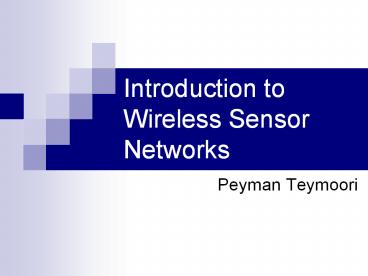Introduction to Wireless Sensor Networks - PowerPoint PPT Presentation
1 / 15
Title:
Introduction to Wireless Sensor Networks
Description:
Introduction to Wireless Sensor Networks Peyman Teymoori Definition Wireless Sensor Networks (WSNs): Highly distributed networks of small, lightweight wireless nodes ... – PowerPoint PPT presentation
Number of Views:133
Avg rating:3.0/5.0
Title: Introduction to Wireless Sensor Networks
1
Introduction to Wireless Sensor Networks
- Peyman Teymoori
2
Definition
- Wireless Sensor Networks (WSNs)
- Highly distributed networks of small, lightweight
wireless nodes, - Deployed in large numbers,
- Monitors the environment or system by measuring
physical parameters such as temperature,
pressure, humidity. - Node
- sensing processing communication
3
Applications of WSNs
- Constant monitoring detection of specific
events - Military, battlefield surveillance
- Forest fire flood detection
- Habitat exploration of animals
- Patient monitoring
- Home appliances
4
Comparison with Ad Hoc Wireless Networks
- Both consist of wireless nodes but they are
different. - The number of nodes is very large
- Being more prone to failure, energy drain
- Not having unique global IDs
- Data-centric, query-based addressing vs.
address-centric - Resource limitations memory, power, processing
5
Design Issues Challenges
- Random deployment ? autonomous setup
maintenance - Infrastructure-less networks ? distributed
routing - Energy, the major constraint ? trading off
network lifetime for fault tolerance or accuracy
of results - Hardware energy efficiency
- Distributed synchronization
- Adapting to changes in connectivity
- Real-time communication, QoS
- Security
6
Design Factors
- Scalability
- Fault tolerance
- Power consumption
- Sensor network architectures
- Layered
- Clustered
7
Layered Architecture
- A single powerful base station (BS)
- Layers of sensor nodes around BS
- Layer i All nodes i-hop away from BS
- Applications
- In-building BS is an access point
- Military
- Short-distance, low power tx
8
Unified Network Protocol Framework (UNPF)
- A layered architecture
- A set of protocols
- Integrates three operations
- Network Initialization Maintenance Protocol
- MAC Protocol
- Routing Protocol
9
Unified Network Protocol Framework (UNPF)
- Network Initialization Maintenance Protocol
- BS broadcasts its ID using CDMA common control
channel (BS reaches all nodes in one hop) - Nodes record BS ID send beacon signal with
their own IDs at their low default power levels - All nodes the BS can hear are at 1-hop distance
- The BS broadcasts a control packet with all layer
one node IDs - All nodes send a beacon signal again
- The layer one nodes record the IDs they
hear-layer 2 - The layer one nodes inform the BS of the layer 2
- The BS broadcasts the layer2 nodes IDs,
- To maintain periodic beaconing updates are
required
10
Unified Network Protocol Framework (UNPF)
- Routing Protocol
- Downlink from the BS is by direct broadcast on
the control channel - Enables multi-hop data forwarding to the BS
- The remaining energy is considered when
forwarding to the next hop (layer) - Only the nodes of the next layer need to be
maintained in the routing table
11
Clustered Architecture
- Organizes the sensor nodes into clusters
- Each cluster is governed by a cluster-head
- Only heads send messages to a BS
- Suitable for data fusion
- Self-organizing
12
Low-Energy Adaptive Clustering Hierarchy (LEACH)
- Self-organizing and adaptive clustering protocol
- Evenly distributes the energy expenditure among
the sensors - Performs data aggregation where cluster heads act
as aggregation points - Two main phases
- Setup phase organizing the clusters
- Steady-state phase deals with the actual data
transfers to the BS
13
Low-Energy Adaptive Clustering Hierarchy (LEACH)
- Setup phase
- Each sensor chooses a random number m between 0
and 1 - If m lt T(n) for node n, the node becomes a
cluster-head where - P the desired percentage of cluster heads
- r the round number
- G the set of nodes that have not been cluster
heads during the last 1 / P rounds - A cluster head advertises its neighbors using a
CSMA MAC. - Surrounding nodes decide which cluster to join
based on the signal strength of these messages - Cluster heads assign a TDMA schedule for their
members
14
Low-Energy Adaptive Clustering Hierarchy (LEACH)
- Steady-state phase
- All source nodes send their data to their cluster
heads - Cluster heads perform data aggregation/fusion
through local transmission - Cluster heads send them back to the BS using a
single direct transmission - After a certain period of time, cluster heads are
selected again through the set-up phase
15
Low-Energy Adaptive Clustering Hierarchy (LEACH)
- Merits
- Accounting for adaptive clusters and rotating
cluster heads - Opportunity to implement any aggregation function
at the cluster heads - Demerits
- Highly dynamic environments
- Continuous updates
- Mobility

